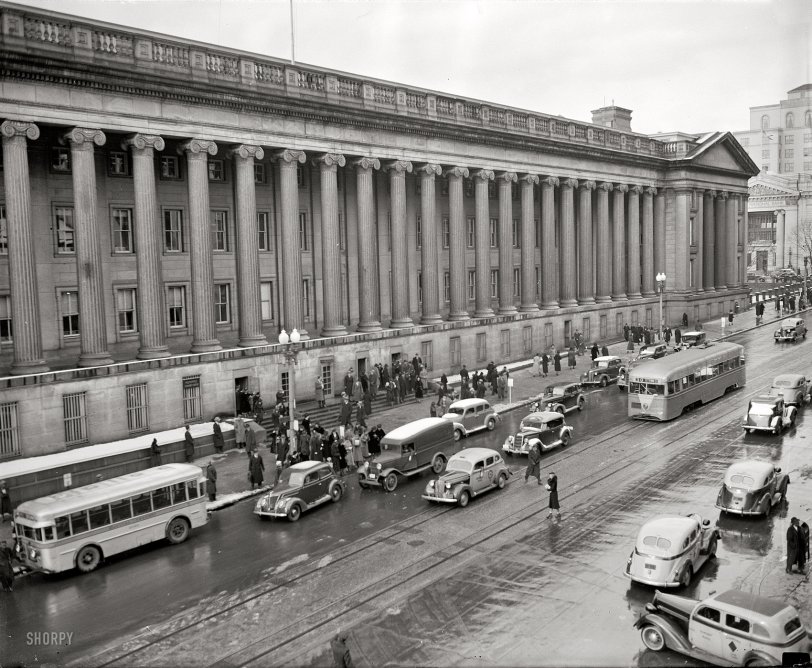


Framed or unframed, desk size to sofa size, printed by us in Arizona and Alabama since 2007. Explore now.
Shorpy is funded by you. Patreon contributors get an ad-free experience.
Learn more.

- Baldwin 62303
- Baldwin VO-1000
- Cold
- No expense spared
- Tough Guys
- Lost in Toyland
- And without gloves
- If I were a blindfolded time traveler
- Smoke Consumer Also Cooks
- Oh that stove!
- Possibly still there?
- What?!?
- $100 Reward
- Freeze Frame
- Texas Flyer wanted
- Just a Year Too Soon
- WWII -- Replacing men with women at the railroad crossing.
- Yes, Icing
- You kids drive me nuts!
- NOT An Easy Job
- I wonder
- Just add window boxes
- Icing Platform?
- Indiana Harbor Belt abides
- Freezing haze
- Corrections (for those who care)
- C&NW at Nelson
- Fallen Flags
- A dangerous job made worse
- Water Stop
Print Emporium
City Sidewalks: 1938

Washington, D.C., circa 1938. "Street scene, U.S. Treasury, Fifteenth Street." Harris & Ewing Collection glass negative. View full size.
My Grandmother
My grandmother might very well be in this photo. She worked at the treasury dept for several years, including 1938. I wish there were some way to zoom in on this in a clear way to make out more details. It would be incredible to see!
[You can download a much larger version here. (Right-click link, choose "save file/target/link as.") - Dave]
Phaeton in the snow
Nice to see a touring car (the '35 Ford Phaeton behind the taxi) in adverse weather. These cars had no side glass, so they were inexpensive, lightweight and stylish, but breezy! The side curtains were so cumbersome that I imagine sometimes they weren't worth the trouble, even in a car that could hit 80 mph.
I also love that '37 Ford flatback sedan. Ford built some of the industry's greatest body shapes in the 1930s.
Driver Arms
I really like the "slow/Stop" arm positions of the drivers of the delivery van and taxi cab while waiting for the '37 Ford to pull away and the lady to cross the street. Most young drivers today most likely not know the meaning of this signal! Common signal then as were the arm positions for left and right turns, too.
Today's City Sidewalks
Back of the Ten-Dollar Bill
Until late 1990s, the reverse of the U.S. $10 bill featured a streetscape very similar to this image. The buildings haven't changed much, but the traffic patterns have. That's Pennsylvania Avenue in the upper right corner, a portion which has since been closed to vehicular traffic in our post 9-11 world [Actually closed since 1996 - Dave]. The "streamlined" streetcar is one of the first of its kind anywhere, built in Philadelphia in 1935 by the J.G. Brill Company and is part of a batch serialed somewhere between 1001 and 1010. This is a close forerunner to the PCC streetcar featured in an earlier post.
Switch Hitters
That's a cool looking bus. It looks like it goes both ways, like the streetcar, but the seats are all facing the front, and a bidirectional bus would be silly.
That's not a PCC
The streetcar looks like a PCC car, but it's actually a pre-PCC built in the mid 1930s before the PCC design was finalized.
























On Shorpy:
Today’s Top 5